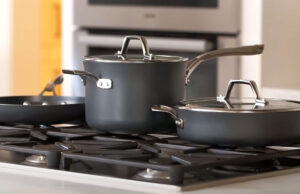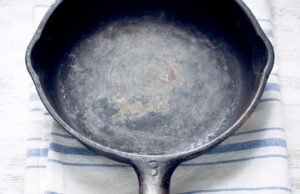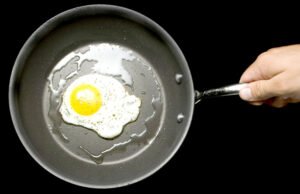As an Amazon Associate, I earn from qualifying purchases at no extra cost to you.
How to Clean Dishwasher with Baking Soda (Simple Steps)
Have you ever opened your dishwasher and noticed a strange smell or leftover grime? It’s surprising how quickly dishwashers can get dirty, even when we use them every day. Sometimes, regular detergent just isn’t enough. So, what can really refresh it without harsh chemicals? In this article, we will explore how to clean dishwasher with baking soda and get it sparkling again.
First, remove food debris and check filters. Then, sprinkle baking soda inside the dishwasher for natural deodorizing. Running a hot water cycle helps lift grime. You can also combine vinegar and baking soda for tough stains. Regular cleaning prevents bad odors and improves performance. Using these tips saves money and avoids harsh chemicals.
Remove Food Debris and Check Dishwasher Filters
Before you start cleaning, take a moment to look inside your dishwasher. Often, crumbs and leftover food get stuck in filters and corners. These can block water flow and cause bad smells. Imagine running a cycle with all that hidden gunk—yikes!
Next, remove the bottom rack carefully to reach the filter. Twist and lift out any debris you find. Sometimes, you’ll notice tiny bits of rice or vegetable peels hiding there. Rinsing the filter under warm water usually does the trick.
It helps to inspect the spray arms too. Small holes can get clogged with mineral deposits. A toothpick or soft brush works well to unclog them. Cleaning these parts ensures water sprays evenly and dishes come out spotless.
Finally, give the inside a quick wipe. Use a damp cloth to remove any visible grime around the door and walls. This small effort prevents buildup and makes the next cleaning cycle with baking soda more effective.
- Remove crumbs and food particles from filters
- Check spray arms for clogs
- Rinse filter under warm water
- Wipe inside walls and door
Sprinkle Baking Soda for Natural Cleaning
Once the dishwasher is clear, it’s time to use baking soda. This simple ingredient works wonders for deodorizing and loosening grime. Sprinkle about one cup of baking soda along the bottom of the dishwasher. You can imagine it as giving your appliance a soft, refreshing scrub from the inside.
Next, run a short hot water cycle. Baking soda reacts gently with the heat, helping to remove residue and stains. You might notice a fresher smell almost immediately. This method works especially well if you run the dishwasher frequently.
For stubborn spots, you can mix baking soda with a few drops of water to create a paste. Apply it to the stains with a sponge or cloth. Let it sit for 10–15 minutes before running a rinse cycle. It’s amazing how something so simple can be so effective.
Sprinkling baking soda is also a preventive habit. Doing this once a month keeps your dishwasher smelling fresh and avoids heavy buildup. It’s cheap, safe, and surprisingly powerful compared to commercial cleaners.
- Sprinkle one cup of baking soda on the bottom
- Run a hot water cycle
- Use a paste for stubborn stains
- Repeat monthly for maintenance
Combine Vinegar for Tough Odors and Stains
If baking soda alone doesn’t remove all the grime, vinegar is a great partner. Pour one cup of white vinegar into a dishwasher-safe container and place it on the top rack. Vinegar naturally breaks down grease and neutralizes odors.
Run a full hot water cycle with vinegar inside. As it circulates, it loosens hard water deposits and food residue. You might see the water look slightly cloudy—that’s normal. After the cycle, your dishwasher will smell noticeably fresher.
For extra effectiveness, follow up with a baking soda sprinkle on the bottom. The two ingredients complement each other, removing lingering stains and odors. Some people even leave a small cup of vinegar in the bottom rack between uses as a preventive trick.
Always remember to wipe the rubber gasket around the door after this cycle. Vinegar can loosen trapped grime there. A damp cloth works perfectly to prevent mold and mildew. Combining vinegar and baking soda creates a simple, chemical-free cleaning duo.
- Place one cup vinegar in top rack
- Run a hot water cycle
- Follow with baking soda if needed
- Wipe door gasket to prevent mold
Clean Dishwasher Racks and Utensil Holders
Dishwasher racks and utensil holders often hide leftover food particles. Removing them makes a big difference in cleaning results. Take out both racks carefully and check every corner. You’ll be surprised at what can collect there.
Soak racks in warm water mixed with baking soda for 15–20 minutes. This softens any stuck-on grime. Then, scrub gently with a sponge or brush. You can also use an old toothbrush to reach small crevices.
Utensil holders need extra attention. Small holes often trap bits of food. Rinse them thoroughly under running water. If necessary, soak them in a baking soda solution for a few minutes.
Once clean, replace racks and holders. You’ll notice your dishwasher works better and dishes come out cleaner. Regular attention to these parts keeps the machine performing at its best.
- Remove racks and utensil holders
- Soak in warm water and baking soda
- Scrub small crevices
- Replace for improved performance
Wipe Dishwasher Door and Seals
Many people forget the dishwasher door and rubber seals. Yet, these areas often hold grime and moisture, causing smells. Wipe the door edges with a damp cloth. Pay attention to small crevices where food can hide.
Rubber seals need gentle cleaning to avoid damage. A soft cloth dipped in warm water with baking soda works perfectly. Gently scrub around the gasket to remove buildup. You may notice mold or mildew forming—don’t worry, this cleans it away easily.
Check the detergent dispenser too. Sometimes residue builds up there and prevents proper detergent flow. Use a small brush or toothpick to clear it. Ensuring these areas are clean improves the dishwasher’s efficiency.
Finally, leave the door slightly open after each cycle. This allows moisture to evaporate and reduces odor. These small habits combined with baking soda make a big difference over time.
- Wipe door edges and crevices
- Clean rubber seals with baking soda
- Check detergent dispenser
- Leave door slightly open to dry
Maintain Regular Dishwasher Cleaning Routine
Keeping your dishwasher fresh requires regular care. Sprinkling baking soda once a month and checking filters can prevent most problems. Think of it as a small habit that saves time and energy later.
Pay attention to smells and performance. If dishes are coming out dull or water isn’t draining, it’s probably time for a cleaning cycle. Combine baking soda and vinegar when needed for deep cleaning. These ingredients are safe and effective.
Another tip is to remove large food particles before loading dishes. This reduces buildup inside the machine. Regular inspection of racks, spray arms, and seals also prevents future problems.
Consistency matters. Even a small monthly cleaning routine can make your dishwasher last longer and perform better. You’ll enjoy sparkling dishes and a fresh-smelling appliance every time.
- Clean filters monthly
- Inspect racks and spray arms
- Remove large food particles
- Combine baking soda and vinegar for deep cleaning
Final Thoughts
Cleaning your dishwasher with baking soda is simple, safe, and effective. It removes odors, lifts stains, and keeps your appliance running smoothly. Combining baking soda with vinegar tackles tougher grime naturally. Regular maintenance, like wiping seals and checking filters, prevents problems before they start. With small, consistent efforts, your dishwasher will stay fresh and your dishes sparkling clean every time.
| Task | Baking Soda Method | Additional Tips |
|---|---|---|
| Remove debris | Check filters and remove food particles | Rinse under warm water |
| Freshen dishwasher | Sprinkle 1 cup baking soda on the bottom | Run a hot water cycle |
| Tough stains | Apply baking soda paste | Let sit 10–15 minutes before rinsing |
| Deodorize | Place 1 cup vinegar on top rack | Follow with baking soda if needed |
| Clean racks | Soak in baking soda water | Scrub with sponge or toothbrush |
| Door & seals | Wipe with damp cloth and baking soda | Leave door slightly open to dry |
| Spray arms | Check holes for clogs | Use toothpick or brush |
| Detergent dispenser | Clear residue | Ensure proper detergent flow |
Frequently Asked Questions (FAQs)
Is it safe to clean my dishwasher with baking soda?
Yes, it is completely safe to clean your dishwasher with baking soda. Baking soda is non-toxic and does not damage the machine. It gently lifts grime and deodorizes without harsh chemicals. You can sprinkle it inside or make a paste for tougher spots. Many people use it monthly as a routine cleaner. For extra cleaning, combining it with vinegar is also safe and effective. Just avoid abrasive scrubbing that could scratch the dishwasher surface. This method works well for both stainless steel and plastic interiors, keeping your appliance fresh.
Can I use baking soda on stainless steel dishwashers?
Absolutely! Baking soda is very safe for stainless steel surfaces. It helps remove water spots and mild stains without scratching. Just sprinkle a small amount on the bottom and run a hot water cycle. For stubborn areas, a paste of baking soda and water works well. Avoid harsh metal scrubbers to protect the finish. Using baking soda regularly keeps stainless steel looking shiny and prevents dulling over time.
Do I need vinegar with baking soda every time?
Not every time. Baking soda alone works for regular cleaning and deodorizing. Vinegar is helpful for tougher stains, hard water deposits, or strong odors. You can alternate: monthly baking soda for maintenance, then vinegar when needed for deep cleaning. This keeps the process simple and avoids unnecessary strong smells. Most people find this combination keeps their dishwasher fresh consistently.
Is it okay to sprinkle baking soda before or after a cycle?
It’s best to sprinkle baking soda before running a hot water cycle. This allows the soda to mix with water and clean the interior evenly. For stubborn stains, you can apply it after a cycle as a paste and let it sit, then rinse. The timing can depend on the level of dirtiness. Overall, doing it before a full cycle usually works well for maintenance.
Can baking soda remove odors completely?
Yes, baking soda is excellent at neutralizing odors. It absorbs smells from leftover food or stagnant water. For persistent odors, combining it with a vinegar cycle enhances results. Regular use prevents buildup and keeps the dishwasher smelling fresh. Many people notice a significant difference after just one cleaning session.
Do I need to remove racks to clean with baking soda?
Removing racks is helpful but not always necessary. It allows you to clean hidden areas, corners, and the bottom thoroughly. If you want a deeper clean, taking racks out and sprinkling baking soda on them is effective. For quick maintenance, you can sprinkle soda without removing racks, but deeper cleaning benefits from full access.
Is baking soda effective for hard water deposits?
Baking soda alone is mild but helps soften mineral buildup. For tough hard water stains, combining it with vinegar improves effectiveness. Vinegar dissolves minerals while baking soda lifts residue. Running a hot water cycle after this combination usually clears deposits. Many people use this trick monthly to prevent hard water buildup.
Can I use baking soda regularly without damaging the dishwasher?
Yes, baking soda is safe for regular use. Using it once a month or every few weeks won’t harm the appliance. It’s gentle, non-corrosive, and keeps the dishwasher clean naturally. Regular use prevents odor, buildup, and residue, improving overall performance. Even with frequent cleaning, it is safer than harsh chemical cleaners.




